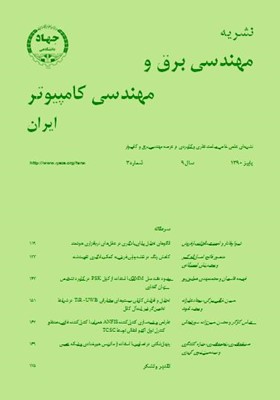طراحي و شبيهسازي كنترلكننده ANFIS همراه با كنترلكننده فازي بهمنظور كنترل توان اكتيو انتقالي توسط TCSC
محورهای موضوعی : مهندسی برق و کامپیوترعباس کارگر 1 * , محسن حسینزاده سورشجانی 2
1 - دانشگاه شهرکرد
2 - دانشگاه صنعتی مالک اشتر شاهینشهر
کلید واژه: كنترل توان انتقالي كنترلكننده فازي TCSC ANFIS,
چکیده مقاله :
كنترل توان اكتيو عبوری از خطوط انتقال بهخصوص در شرايط تراکم یا وقوع خطا يكي از مهمترين مسایل پيش رو در کنترل و مديريت صحيح سيستمهاي قدرت است. در اين شرايط براي كنترل پيوسته و بهخصوص افزايش توان انتقالي، عمدتاً از خازن سري كنترلشونده با تريستور (TCSC) استفاده ميشود كه در واقع بهعلت قابليت سريع كنترل تريستورها و توانايي در پايدار نگهداشتن سيستم حين بروز خطاهاي متفاوت ميباشد. در اين مقاله به كنترل توان اكتيو انتقالي در محدوده تقريباً 10 مگاواتي به كمك TCSCپرداخته شده است. براي كنترل زاويه آتش TCSC از كنترلكنندههاي مختلف اعم از كنترلكننده PID، فازي و ANFIS استفاده شده و با توجه به نتايج حاصل از شبيهسازي، مزايا و معايب هر يك از اين كنترلكنندهها بررسي شده است. كنترلكننده ANFIS نيز بهصورت حلقهباز پيادهسازي شده و داراي پاسخ گذراي بسيار مناسبي است. عيب اين نوع پيادهسازي خطاي حالت ماندگار آن بوده و نسبت به تغيير پارامترها نيز بسيار حساس ميباشد. لذا براي رفع اين مشكلات ميتوان آن را با كنترلكننده فازي طراحيشده تركيب كرد و در عين سادگي، عملكرد بسيار مناسبي از مجموعه بهدست آورد.
Control of transmitted active power is an important issue in operation and management of power systems especially in congestion or fault conditions. In these situations, Thyristor Controlled Series Capacitor (TCSC) is used to continuous control and increase the transmitted power due to these facts that TCSC can act dynamically and is able to stable the system during fault conditions. In this paper, the transmitted power is controlled in the ten megawatt span by using the TCSC. For this purpose, various controllers such as PID, fuzzy and Adaptive Network-based Fuzzy Interface System (ANFIS) are designed to continuous control of the transmitted power. Simulation results evaluate advantages and disadvantages these controllers. ANFIS controller is designed by open loop method which has a good transient response. However, it has a large steady state error and is very sensitive to the variations in system. Fuzzy and ANFIS controllers are combined to remove these defects. The simulation results verify the advantages of the fuzzy-ANFIS controller with respect to the other designed controllers.
[1] K. R. Padiyar, FACTS Controllers in Power Transmission and Distribution, Tunbridge Wells: Anshan, 2009.
[2] N. G. Hingorani and L. Gyugyi, Understanding FACTS: Concepts and Technology of Flexible AC Transmission Systems, New York: Institute of Electrical and Electronics Engineers, 1999.
[3] S. G. Jalali, R. A. Hedin, M. Pereira, and K. Sadek, "A stability model for the advanced series compensator (ASC)," IEEE Trans. Power Delivery, vol. 11, no. 2, pp. 1128-1137, Apr. 1996.
[4] C. R. Fuerte - Esquivel, E. Acha, and H. Ambriz - Perez, "A thyristor controlled series compensator model for the power flow solution of practical power networks," IEEE Trans. Power Systems, vol. 15, no. 1, pp. 58-64, Feb. 2000.
[5] S. G. Jalali, R. H. Lasseter, and I. Dobson, "Dynamic response of a thyristor controlled switched capacitor," IEEE Trans. Power Delivery, vol. 9, no. 3, pp. 1609-1615, Jul. 1994.
[6] A. Ghosh and G. Ledwich, "Modelling and control of thyristor - controlled series compensators," in IEE Proc. Generation, Transmission, and Distribution, vol. 142, no. 3, pp. 297-304, May 1995.
[7] P. Mattavelli, G. C. Verghese, and A. M. Stankovic, "Phasor dynamics of thyristor controlled series capacitor systems," IEEE Trans. Power System, vol. 12, no. 2, pp. 1259-1267, Aug. 1997.
[8] D. Jovcic and G. N. Pillai, "Analytical modeling of TCSC dynamics," IEEE Trans. Power Delivery, vol. 20, no. 2, pp. 1097-1104, Apr. 2005.
[9] A. M. Stankovic, P. Mattavelli, and R. Ortega, "On the nonlinear control of TCSC," in Proc. of the 35th Annual Hawaii International Conf. on System Sciences, pp. 841-846, Jan. 2002.
[10] X. Nong and L. Dichen, "Nonlinear stabilized controller design for TCSC," in IEEE Conf. Electric Utility Deregulation and Restructuring and Power Technologies, pp. 2069-2099, Apr. 2008.
[11] G. Escobar, A. M. Stankovic, P. Mattavelli, and R. Ortega, "A comparative study of three nonlinear controllers for TCSC," in Power Tech Proc., vol. 2, Porto, Sep. 2001.
[12] R. Ghazi, A. Azemi, and K. Pour Badakhshan, "Adaptive fuzzy sliding mode control of SVC and TCSC for improving the dynamic performance of power systems," in Proc. 7th Int. Conf. on AC - DC Power Transmission, IET Conf., pp. 333-337, Nov. 2001.
[13] T. Sansawatt and I. Ngamroo, "Sliding mode control design of TCSC for robust power system stabilization using dynamic compensation observer technique," in Proc. 41st Int. Conf. UPEC '06, vol. 2, pp. 447-451, Sep 2006.
[14] U. Yolac and T. Yalcinoz, "Comparison of fuzzy logic and PID controllers for TCSC using Matlab," in Proc. 39th Int. Conf. UPEC '04, vol. 1, pp. 438-442, Sep. 2004.
[15] X. Tan, N. Zhang, L. Tong, and Z. Wang, "Fuzzy control of thyristor - controlled series compensator in power system transients," Fuzzy Sets and Systems, vol. 110, no. 3, pp. 429-436, May 2000.
[16] S. Hameed, "Power system stability enhancement using reduced rule base self - tuning fuzzy PI controller for TCSC," in Proc. IEEE PES Transmission and Distribution Conf. and Exposition, 8 pp., Apr. 2010.
[17] A. Oudalov, R. Cherkaoui, and A. J. Germond, "Application of fuzzy logic techniques for the coordinated power flow control by multiple series FACTS devices," in Proc. Power Industry Computer Applications, PICA 2001, pp. 74-80, May 2001.
[18] S. A. Nabavi Niaki, R. Iravani, and M. Noroozian, "Power - flow model and steady - state analysis of the hybrid flow controller," IEEE Trans. Power Delivery, vol. 23, no. 4, pp. 2330-2338, Oct. 2008.
[19] J. S. R. Jang, "ANFIS: adaptive - network - based fuzzy inference system," IEEE Trans. Systems, Man, and Cybernetics, vol. 23, no. 3, pp. 665-685, May/Jun. 1993.

